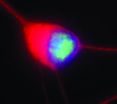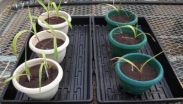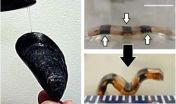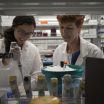(Press-News.org) New findings reveal how a mutation, a change in the genetic code that causes neurodegeneration, alters the shape of DNA, making cells more vulnerable to stress and more likely to die.
The particular mutation, in the C9orf72 gene, is the most common cause for amyotrophic lateral sclerosis (ALS, also known as Lou Gehrig's disease), and frontotemporal degeneration (FTD), the second most common type of dementia in people under 65.
This research by Jiou Wang, Ph.D., and his colleagues at Johns Hopkins University (JHU) was published in Nature and was partially funded by the National Institutes of Health's National Institute of Neurological Disorders and Stroke (NINDS).
In ALS, the muscle-activating neurons in the spinal cord die, eventually causing paralysis. In FTD neurons in particular brain areas die leading to progressive loss of cognitive abilities. The mutation may also be associated with Alzheimer's and Huntington's diseases.
DNA contains a person's genetic code, which is made up of a unique string of bases, chemicals represented by letters. Portions of this code are divided into genes that provide instructions for making molecules (proteins) that control how cells function. The normal C9orf72 gene contains a section of repeating letters; in most people, this sequence is repeated two to 25 times. In contrast, the mutation associated with ALS and FTD can result in up to tens of thousands of repeats of this section.
Using sophisticated molecular techniques, Dr. Wang and his team showed that the mutation causes changes in the three-dimensional shape of DNA. DNA is normally shaped like a twisted ladder. However, the repeating sequences can fold into G-quadruplexes, stacks of square-shaped molecules known as G-quartets. "This structure has been described as a square building with each floor representing one G-quartet, normally two to four stories high," said Dr. Wang, senior author of the paper.
Their results also showed that C9orf72 mutated DNA has profound effects on how the genetic message is processed in the cell. RNA, short for ribonucleic acid, acts as an important intermediary — a middleman — in the process that converts genetic information from DNA into functional proteins. This happens in two stages: conversion of the DNA code into RNA is called transcription. RNA then forms proteins during a process known as translation.
The investigators discovered that the mutated DNA forms DNA-RNA hybrid structures called R loops. Then they showed that G-quadruplexes and R-loops interfered with the transcription process. Cells taken from patients (containing the C9orf72 mutation) produced shorter transcription products (or transcripts) compared with control cells (without the mutation) taken from healthy volunteers.
These short transcripts result in abnormal functioning of the cell and can lead to cell death. "Unfortunately, these alternative DNA arrangements impede normal processing, much like a car encountering a series of speed bumps or the occasional roadblock while traveling to its destination," said Dr. Wang.
Findings from Dr. Wang's team also suggest that the C9orf72 mutation has an effect in the nucleolus, a cellular structure located within the nucleus (which contains the cell's DNA) and the site where initial steps in protein assembly occur. The nucleolus also plays a key role in directing the cell's response to stress.
The key protein inside the nucleolus is nucleolin. Dr. Wang teamed with Jeffrey D. Rothstein, M.D., from JHU, to study the effects of the C9orf72 mutation on nucleolin. They found that binding of the short transcription products formed by the C9orf72 mutation to nucleolin has toxic effects on cells. The researchers show that in healthy cells without the mutation, nucleolin is present only in a certain area of the nucleus, but in cells obtained from ALS patients, nucleolin is scattered throughout the nucleus. They postulate that abnormal distribution of nucleolin causes cells to become stressed and more likely to die, which can result in the pathology associated with ALS and FTD.
For those experiments, the researchers used induced pluripotent stem cells (iPSC) containing the C9orf72 mutation that were derived from the skin of ALS patients. The iPSCs can be turned into different types of cells, in this case into motor neurons, which are the cells that die in patients with ALS. The iPSC technology lets scientists study in a dish the direct effects of disease-causing human mutations on brain or spinal cord cells.
"Our new study, along with previous work, highlight the great power of ALS iPSCs," said Dr. Wang.
Dr. Rothstein is the director of the ALS iPSC Consortium, which is managed by NINDS. The consortium is a resource that was created in 2009 to develop iPSCs for the study of genetic forms of ALS. The iPSCs are stored at the NINDS Human Genetics Repository and are available for use by researchers.
"The availability of iPSCs from patients and healthy volunteers enabled Dr. Wang and his collaborators to address directly the consequences of the C9orf72 mutation in human motor neurons, the brain cells responsible for movement," said Margaret Sutherland, Ph.D., program director at NINDS.
"The findings described in Dr. Wang's paper open up a new pathogenic mechanism for ALS and FTD by providing insight into the biology associated with the C9orf72 mutation and identifying a potential path forward for therapy development," said Dr. Sutherland. For example, the alternative DNA structures (G-quadruplexes and R-loops) may be targets for potential drugs.
"Understanding the biology of C9orf72 is fundamentally important as we work with pharmaceutical companies to develop therapies for these highly devastating diseases," said co-author Dr. Rothstein.
Further research is needed to provide a complete understanding of how the C9orf72 mutation leads to disease.
INFORMATION:
References:
Aaron R. Haeusler et al. "C9orf72 Nucleotide Repeat Structures Initiate Molecular Cascades of Disease," Nature, March 5, 2014.
For more information about ALS, please visit:
http://www.ninds.nih.gov/disorders/amyotrophiclateralsclerosis/ALS.htm
For more information about FTD, please visit:
http://www.ninds.nih.gov/disorders/picks/picks.htm and http://www.ninds.nih.gov/disorders/dementias/detail_dementia.htm
NINDS is the nation's leading funder of research on the brain and nervous system. The mission of NINDS is to seek fundamental knowledge about the brain and nervous system and to use that knowledge to reduce the burden of neurological disease.
About the National Institutes of Health (NIH): NIH, the nation's medical research agency, includes 27 Institutes and Centers and is a component of the U.S. Department of Health and Human Services. NIH is the primary federal agency conducting and supporting basic, clinical, and translational medical research, and is investigating the causes, treatments, and cures for both common and rare diseases. For more information about NIH and its programs, visit http://www.nih.gov.
3-D changes in DNA may lead to a genetic form of Lou Gehrig's disease
NIH-funded scientists reveal how a genetic code variation results in devastating brain diseases
2014-03-05
ELSE PRESS RELEASES FROM THIS DATE:
Look back at US soybeans shows genetic improvement behind increased yields
2014-03-05
URBANA, Ill. – Soybean improvement through plant breeding has been critical over the years for the success of the crop. In a new study that traces the genetic changes in varieties over the last 80 years of soybean breeding, researchers concluded that increases in yield gains and an increased rate of gains over the years are largely due to the continual release of greater-yielding cultivars by breeders.
"This research in some ways looks back and informs us how soybean varieties have changed. It's useful to document these traits and changes," said Brian Diers, a University ...
Fertility prospects following ectopic pregnancy
2014-03-05
WINSTON-SALEM, N.C. – March 5, 2014 – Preserving a fallopian tube following an ectopic pregnancy seems like it would favor a woman's fertility prospects, right?
A new study from Wake Forest Baptist Medical Center looked at pregnancy outcomes in regards to the two surgical treatments for ectopic pregnancy -- salpingectomy, in which the affected fallopian tube is removed, or salpingotomy, in which the tube is preserved.
The aim of the study, said co-author Tamer Yalcinkaya, M.D., a reproductive endocrinologist at Wake Forest Baptist, was to assess whether salpingotomy ...
Maize and bacteria: A 1-2 punch knocks copper out of stamp sand
2014-03-05
Scientists have known for years that together, bacteria and plants can remediate contaminated sites. Ramakrishna Wusirika, of Michigan Technological University, has determined that how you add bacteria to the mix can make a big difference.
He has also shed light on the biochemical pathways that allow plants and bacteria to clean up some of the worst soils on the planet while increasing their fertility.
Wusirika, an associate professor of biological sciences, first collected stamp sands near the village of Gay, in Michigan's Upper Peninsula. For decades, copper mining ...
NASA tests new robotic refueling technologies
2014-03-05
NASA has successfully concluded a remotely controlled test of new technologies that would empower future space robots to transfer hazardous oxidizer – a type of propellant – into the tanks of satellites in space today.
Concurrently on the ground, NASA is incorporating results from this test and the Robotic Refueling Mission on the International Space Station to prepare for an upcoming ground-based test of a full-sized robotic servicer system that will perform tasks on a mock satellite client.
Collectively, these efforts are part of an ongoing and aggressive technology ...
OU study suggests non-uniform climate warming global
2014-03-05
A recent University of Oklahoma study of five decades of satellite data, model simulations and in situ observations suggests the impact of seasonal diurnal or daily warming varies between global regions affecting many ecosystem functions and services, such as food production, carbon sequestration and climate regulation. The effects of non-uniform climate warming on terrestrial ecosystems is a key challenge in carbon cycle research and for those making future predictions.
Jianyang Xia, a research associate in the OU College of Arts and Sciences, says the impact of non-uniform ...
A small step toward discovering habitable earths
2014-03-05
University of Arizona researchers snapped images of a planet outside our solar system with an Earth-based telescope using essentially the same type of imaging sensor found in digital cameras instead of an infrared detector. Although the technology still has a very long way to go, the accomplishment takes astronomers a small step closer to what will be needed to image earth-like planets around other stars
"This is an important next step in the search for exoplanets because imaging in visible light instead of infrared is what we likely have to do if we want to detect planets ...
Researchers find potential target for drug to treat allergic asthma
2014-03-05
COLUMBUS, Ohio – An enzyme that helps maintain immune system function by "throwing away" a specific protein has a vital role in controlling symptoms of allergic asthma, new research in mice suggests.
The finding suggests that this enzyme, called Cbl-b, could be a target for drugs used to treat allergic asthma and other autoimmune disorders.
This new study, led by Ohio State University researchers, is the first to link Cbl-b to allergic asthma in an animal model.
The findings parallel results from a 2012 Yale study in humans, which suggested that a mutation in the ...
Pumping iron: A hydrogel actuator with mussel tone
2014-03-05
Protein from a small, tasty mollusk inspired Michigan Technological University's Bruce P. Lee to invent a new type of hydrogel actuator.
Hydrogels are soft networks of polymers with high water content, like jello. Because of their soft, gentle texture, they have the potential to interact safely with living tissues and have applications in a number of medical areas, including tissue engineering. Lee, an assistant professor of biomedical engineering, wanted to make a hydrogel that wouldn't just sit there.
"Hydrogels that can change shape on command could be used to deliver ...
Going viral to target tumors
2014-03-05
March 5, 2014, New York, NY– A Ludwig Cancer Research study suggests that the clinical efficacy of checkpoint blockade, a powerful new strategy to harness the immune response to treat cancers, might be dramatically improved if combined with oncolytic virotherapy, an investigational intervention that employs viruses to destroy tumors.
Published today in the journal Science Translational Medicine, the study evaluated a combination therapy in which the Newcastle disease virus (NDV), a bird virus not ordinarily harmful to humans, is injected directly into one of two melanoma ...
Biomarkers of cell death in Alzheimer's reverse course after symptom onset
2014-03-05
Three promising biomarkers being studied to detect Alzheimer's disease in its early stages appear to undergo a surprising shift as patients develop symptoms of dementia, researchers at Washington University School of Medicine in St. Louis report.
Scientists use the biomarkers to assess brain changes linked to the disease in research volunteers. The levels of markers of neuronal injury increase in the spinal fluid for a decade or more before the onset of dementia, but in a new twist, the research shows for the first time that they later reverse course, decreasing as symptoms ...
LAST 30 PRESS RELEASES:
The impact of family dynamics on eating behaviour – how going home for Christmas can change how you eat
Tracing the quick synthesis of an industrially important catalyst
New software sheds light on cancer’s hidden genetic networks
UT Health San Antonio awarded $3 million in CPRIT grants to bolster cancer research and prevention efforts in South Texas
Third symposium spotlights global challenge of new contaminants in China’s fight against pollution
From straw to soil harmony: International team reveals how biochar supercharges carbon-smart farming
Myeloma: How AI is redrawing the map of cancer care
Manhattan E. Charurat, Ph.D., MHS invested as the Homer and Martha Gudelsky Distinguished Professor in Medicine at the University of Maryland School of Medicine
Insilico Medicine’s Pharma.AI Q4 Winter Launch Recap: Revolutionizing drug discovery with cutting-edge AI innovations, accelerating the path to pharmaceutical superintelligence
Nanoplastics have diet-dependent impacts on digestive system health
Brain neuron death occurs throughout life and increases with age, a natural human protein drug may halt neuron death in Alzheimer’s disease
SPIE and CLP announce the recipients of the 2025 Advanced Photonics Young Innovator Award
Lessons from the Caldor Fire’s Christmas Valley ‘Miracle’
Ant societies rose by trading individual protection for collective power
Research reveals how ancient viral DNA shapes early embryonic development
A molecular gatekeeper that controls protein synthesis
New ‘cloaking device’ concept to shield sensitive tech from magnetic fields
Researchers show impact of mountain building and climate change on alpine biodiversity
Study models the transition from Neanderthals to modern humans in Europe
University of Phoenix College of Doctoral Studies releases white paper on AI-driven skilling to reduce burnout and restore worker autonomy
AIs fail at the game of visual “telephone”
The levers for a sustainable food system
Potential changes in US homelessness by ending federal support for housing first programs
Vulnerability of large language models to prompt injection when providing medical advice
Researchers develop new system for high-energy-density, long-life, multi-electron transfer bromine-based flow batteries
Ending federal support for housing first programs could increase U.S. homelessness by 5% in one year, new JAMA study finds
New research uncovers molecular ‘safety switch’ shielding cancers from immune attack
Bacteria resisting viral infection can still sink carbon to ocean floor
Younger biological age may increase depression risk in older women during COVID-19
Bharat Innovates 2026 National Basecamp Showcases India’s Most Promising Deep-Tech Ventures
[Press-News.org] 3-D changes in DNA may lead to a genetic form of Lou Gehrig's diseaseNIH-funded scientists reveal how a genetic code variation results in devastating brain diseases





